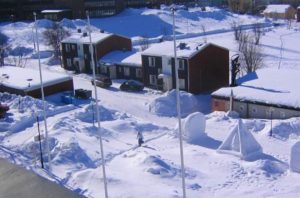by Kullman, Feb 6, 2023 in NoTricksZone
Claims the Swedish Scandes are unprecedentedly warm and tree-covered today “appear as large and unfounded exaggerations,” as the “climate and arboreal responses” of the last few decades “are still inside the frames of natural historical variation.” – Kullman, 2022 and Kullman, 2022a
Extensive birch forest fossils can be dated to the early- to mid-Holocene in northern Scandinavian regions, indicating these warmth-sensitive trees could exist in climates that are too cold for them to grow in today. This documents a much warmer period, “at least 3°C higher than during the past few decades,” 3000 to 10,000 years ago, or when CO2 was about 265 ppm (Kullman, 2022).
Contrary to modeler opinions, “there is little factual nourishment” to support modern projections that the Swedish Scandes will soon be returning to the subalpine birch forest climates of past millennia. The observed forest advancement in recent decades “is so small” that these modeling claims appear to be “unfounded exaggerations.”
“In the southernmost Swedish Scandes, pine has already “leap-frogged” over receding the birch forest-limit (Kullman 2014, 2019). That scenario would mimic the arboreal landscape during the early Holocene and shift to a landscape unseen for thousands of years (cf. Blűthgen 1942; MacDonald et al. 2008, Macias-Fauria et al. 2012). During that epoch, summer temperatures are inferred to have been at least 3°C higher than during the past few decades.”
“At the landscape level, the obtained changes contribute to a greater and lusher landscape, in contrast to the dire conditions during the Little Ice Age, more than 100 years ago (Kullman 2010, 2015). Currently, there is little factual nourishment to flourishing projections stating that a major part of Swedish alpine areas is on verge of transformation to subalpine birch forest (e.g. Moen et al. 2004). Apparently, climate and arboreal responses are still inside the frames of natural historical variation, as inferred by several authors (e,g. Hammarlund et al. 2004; Bergman et al. 2005; Kullman 2013, 2017a, b; Kullman & Öberg 2018, 2020).”
“Given that the current relatively warm climate phase continues, the subalpine birch forest belt may eventually recede and give way to a subalpine pine belt. The obtained modest forest-limit advancement is so small that flourishing model simulations of extensive birch forest expansion over most of the current alpine tundra appear as large and unfounded exaggerations.”
Tree remnants (trunks, cones, roots, etc.) found at northern Sweden mountain sites 500 to 700 meters atop where the 21st century tree line ends imply the early-Holocene (~13,000 to 7000 years ago) climate was significantly warmer than today in this region (Kullman, 2022a).
The temperature lapse rate for the Swedish Lapland region is 0.6°C/100 m. Accounting for glacio-isostatic uplift, this tree line elevation implies surface air temperatures were 3.6°C higher than today during the Early Holocene.
….


